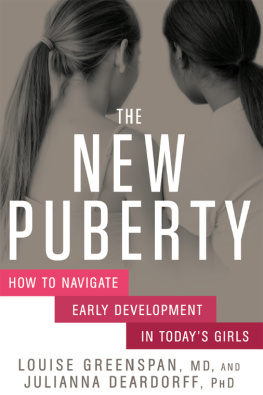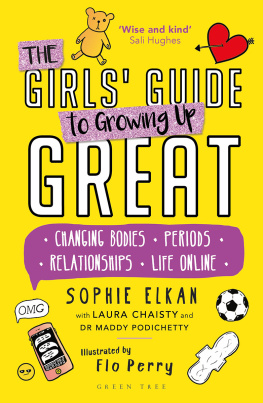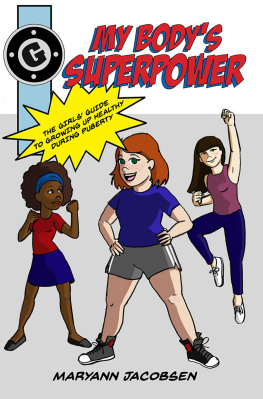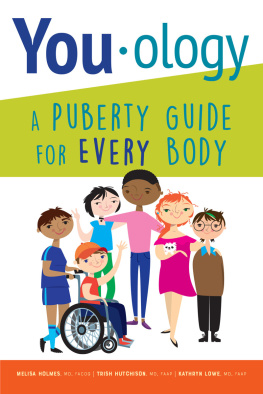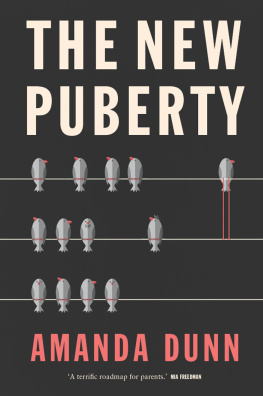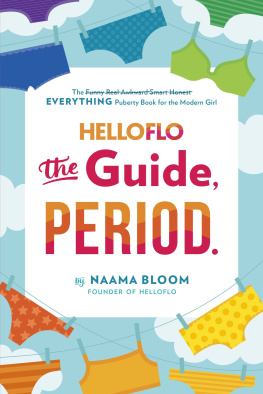Mention of specific companies, organizations, or authorities in this book does not imply endorsement by the author or publisher, nor does mention of specific companies, organizations, or authorities imply that they endorse this book, its author, or the publisher. Internet addresses and telephone numbers given in this book were accurate at the time it went to press.
2014 by Louise Greenspan, MD, and Julianna Deardorff, PhD
All rights reserved. No part of this publication may be reproduced or transmitted in any form or by any means, electronic or mechanical, including photocopying, recording, or any other information storage and retrieval system, without the written permission of the publisher.
Book interior design by Carol Angstadt
Library of Congress Cataloging-in-Publication Data is on file with the publisher.
ISBN 978-1-62336-342-0
eISBN 978-1-62336-343-7

We inspire and enable people to improve their lives and the world around them.
rodalebooks.com
To the children weve worked with and treated through the years, for teaching us what its like to grow up today.
To the children well never meet, for this is why we wrote the book.
And to our own children, EB, JB, RC, and AC, for being a parents greatest teacher.
CONTENTS
Is She Entering Puberty Early?
How We Define Puberty Today
The Potential Repercussions of Early Puberty
An In-Depth Look at Puberty Prompters
How to Know When to Medically Intervene
Practicing the Precautionary Principle
Establishing Healthy Habits
Inside the Brain of a Developing Girl
Building Emotional Closeness
Are you there God? Its me, Margaret. I just told my mother I want a bra. Please help me grow, God. You know where.
Judy Blume, Are You There God?
Its Me, Margaret (1970)
INTRODUCTION
WELCOME TO THE NEW PUBERTY
Is She Entering Puberty Early?
ISABELS TRANSITION INTO PUBERTY WAS like that of millions of other girls, from a purely physical standpoint. After Isabel complained of discomfort in her left nipple, her mother noticed a bump under it that started to grow bigger. Within a few weeks, the same thing happened to her right nipple. The pediatrician noticed that Isabels height had edged out of the average range since her last visit, and she was now taller than most of her peers. When the doctor examined Isabels breasts, she confirmed that Isabel was developing breast tissue even though she had no pubic hair yet.
All of this would have reflected an ordinary start of puberty had it not been for one significant difference: Isabel wasnt a preteen with dreams of dancing with her current crush. She was just years old. When the doctor ordered a bone age x-ray, which would reveal how old Isabel was from a physiological standpoint, the results indicated that Isabels bones were as biologically mature as those of a 9-year-old. (An image of the wrist and hand can determine if theres been long-term estrogen exposure, which causes early maturation.) Further testing demonstrated that the hormones responsible for triggering her physical changes were coming from her pituitary gland, the initiator of puberty, which signals certain hormones to instigate the process. To rule out any rare anomalies like a brain tumor that could have sparked puberty, the doctor also ordered an MRI. Fortunately, it didnt reveal any abnormalities, so Isabel was deemed to be an otherwise healthy girl beginning puberty during the phase of her life when she was still playing house with her dolls.
Welcome to the new puberty.
If youve found yourself in panicky discussions with other parents or been reading media coverage about girls developing faster these days and entering puberty at an earlier age than previous generations, the reports are true. Indeed, a growing number of young girls are being catapulted into early physical development long before they are socially and emotionally ready for the change. According to the National Institutes of Health, puberty typically happens between ages 8 and 13 for girls, ending with sexual maturity and the ability to reproduce. Just a generation ago, less than 5 percent of girls started puberty before the age of 8; today, that percentage has more than doubled. In fact, our longitudinal study as part of the Breast Cancer and the Environment Research Program (BCERP), which assessed the onset of puberty in more than 1,200 girls who have been tracked since 2005 across three cities and was published in the medical journal Pediatrics in 2010, found that by age 7, more than 10 percent of Caucasian girls in America had started growing breasts, along with almost 25 percent of African American girls and 15 percent of Hispanic girls. And by age 8, those percentages had spiked to 18, 43, and 31, respectively. This begs the question: Whats going on?
Well answer that important question in this book. What hasnt changed is that puberty typically starts with breast development, then armpit and pubic hair, acne, a growth spurt, and, finally, menstruation. While its easy to start wondering how environmental chemicals or dietary choices may be affecting our childrens development, the new puberty reflects a much more complex set of circumstances than most people think. And its often not nearly as dramatic as some feature stories would have you believe. Although many journalists have portrayed extremes, profiling 5-year-olds with the body odor of a teenager and shopping for bras with their mothers before heading to kindergarten, such examples are truly exceptional. The facts of early puberty for most girls are much less intimidating. In fact, even the words puberty and normal are grossly misunderstood by many people because popular perceptions of what is meant by these terms dont reflect the scientific literature. The good news is that despite the medias somewhat sensationalistic slant on this rapid turn of events for modern girls coming of age, this book aims to quell fears that going through puberty early is necessarily bad (or that theres something wrong).
That said, traditional wisdom about how to help a child through puberty falls short when it comes to caring for a girl facing this transition early in her life. Parents, teachers, and professionals who work with children need much more than advice on how to talk about physical changes and sex; they require a host of skills that will help them teach girls how to appreciate and love their changing bodies and nurture their evolving identities, and also to help girls manage the eventual health risks their early puberty might carry. (Often these conversations dont even mention the birds and the bees.)
Girls who enter puberty early fall into two categories: There are the rare girls with known disorders like Central Precocious Puberty, wherein a girls pubertal process starts abnormally early for unknown reasons or due to a defect in the nervous system, and then there are the bulk of the girls, who simply develop on the early side of the normal curve. But defining this normal curve has been a moving target for us in the medical community. Continual shifts in our scientific thinking about what characterizes a healthy normal-but-early puberty have not only provoked some debate among the experts who study it, but also led to much confusion and misinformation among the public. Throughout this book, we will dispel myths that have unfortunately begun to circulate over the last decade, since early puberty became a popular topic for discussion.

